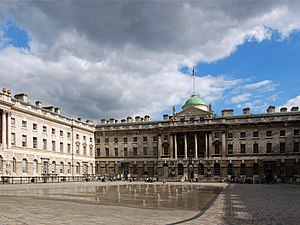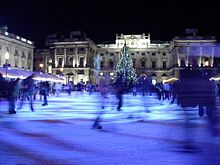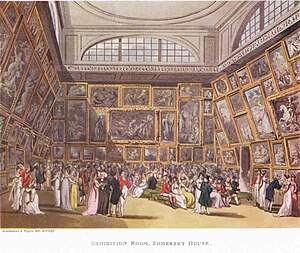| Revision as of 17:18, 29 January 2007 editBob Castle (talk | contribs)Autopatrolled, Extended confirmed users, Pending changes reviewers, Rollbackers17,110 editsm →Early history: linked Old St Paul's cathedral← Previous edit | Revision as of 03:56, 18 March 2007 edit undoRaptornet (talk | contribs)261 editsm I included the country it is located in.Next edit → | ||
| Line 1: | Line 1: | ||
| ] of Somerset House in ]. The pavement fountain was installed in the ].]] | ] of Somerset House in ], ]. The pavement fountain was installed in the ].]] | ||
| '''Somerset House''' is a large building |
'''Somerset House''' is a large building located in ], ], overlooking the ]. The central block of the ] building, the outstanding project of the ] Sir ], dates from ]–]. It was extended by classical ] wings to north and south. A building of the same name was first built on the site more than two centuries earlier. | ||
| ==Early history== | ==Early history== | ||
Revision as of 03:56, 18 March 2007

Somerset House is a large building located in London, England, overlooking the River Thames. The central block of the Neoclassical building, the outstanding project of the architect Sir William Chambers, dates from 1776–96. It was extended by classical Victorian wings to north and south. A building of the same name was first built on the site more than two centuries earlier.
Early history

In the sixteenth century, when poets could still write of the "silvery" Thames without inviting ridicule and salmon could still be netted in the river, the north bank between London and Westminster was a favoured site for the mansions of the nobility. In 1539, Edward Seymour, Earl of Hertford, obtained a grant of land at "Chester Place, outside Temple Bar, London" from Henry VIII of England. When the sickly boy-king Edward VI of England came to the throne in 1547, Seymour became Duke of Somerset and Lord Protector. About 1549 he pulled down an old Inn of Chancery and other houses that stood on the site and began to build himself a truly imposing residence, making liberal use of the other nearby buildings including some of the chantries and cloisters at St. Paul's Cathedral which were demolished at the behest of Somerset and other leading Protestant nobles as part of the ongoing Dissolution of the Monasteries. It was a two storey house built around a quadrangle with a gateway rising to three stories and was one of the earliest examples of Renaissance architecture in England. It is not known who designed the building.
Before it was finished however Somerset created too many enemies for himself in the Council. In the struggle for power he was overthrown and in 1552 paid the price on Tower Hill. "Somerset Place" then came into the possession of the Crown and was used by Princess Elizabeth for some years before she was crowned Elizabeth I of England in 1558.
For a long time thereafter it served as one of the Royal palaces. Elizabeth I lived there during the reign of her sister Mary I of England and it was used as a residence by the Queens of James I, Charles I, and Charles II. During the reign of James I (also referred to as James VI of Scotland), the building became the London residence of his wife Anne of Denmark and was renamed "Denmark House". She commissioned a number of expensive additions and improvements, some to designs by Inigo Jones. This expansion of the building continued during Charles I's reign, including the then highly controversial addition by his wife, Henrietta Maria, of a Roman Catholic chapel (also designed by Jones - who was later to die at Somerset House, in 1652).
The process of completion and improvement was slow and costly. As late as 1598 Stow refers to it as "yet unfinished" and the Stuarts employed Inigo Jones in its embellishment. In particular, during the period between 1630 and 1635 he built a Chapel where Henrietta Maria, Queen of Charles I, could exercise her Roman Catholic religion. This was in the care of the Capuchin Order and was on a site to the south-west of the Great Court. A small cemetery was attached and some of the tombstones are still to be seen built into one of the walls of a passage under the present quadrangle.
Royal occupation of Somerset House was interrupted by the English Civil War and in 1649 Parliament tried to sell it. They failed to find a buyer, though a sale of the contents realised the very considerable sum (for then) of £118,000. Use was still found for it however. Part of it served as an Army headquarters, General Fairfax (the Parliamentary Commander-in-Chief) being given official quarters there; lodgings were also provided for certain other Parliamentary notables. It was in Somerset House that Oliver Cromwell's body lay in state after his death in 1658.
Two years later, with the Restoration, Henrietta Maria returned and began a considerable programme of rebuilding in 1661, the main feature of which was a magnificent new river front, again to the design of Inigo Jones. However she returned to France in 1665 before it was finished. It was then used as an occasional residence by Catherine of Braganza, Queen of Charles II. During her time it received a certain notoriety as being, in the popular mind, a hot-bed of Catholic conspiracy. Titus Oates made full use of this prejudice in the fabricated details of the Popish Plot and it was alleged that Sir Edmund Berry Godfrey, whose murder was one of the great mysteries of the age, had been killed in Somerset House before his body had been smuggled out and thrown into a ditch below Primrose Hill.
Somerset House was refurbished by Sir Christopher Wren in 1685. After the Glorious Revolution in 1688, Somerset House entered on a long period of decline, being used (after Catherine left England in 1692) for grace and favour residences. In the conditions of the time this meant almost inevitably that little money could be found for its upkeep and a slow process of decay crept in. During the 18th century, however, the building ceased its royal associations. Though the view from its terraced riverfront garden, open to the public, was painted twice on his London visit by Canaletto (looking upriver and down), it was used for storage, as a residence for visiting overseas dignatories and as a barracks for troops. Suffering from neglect, demolition began in 1775.
Current building

Ever since the middle of the 18th century there had been growing criticism that London had no great public buildings. Government departments and the Learned Societies were huddled away in small old buildings all over the city. Developing national pride found comparison with the capitals of the Continent disquieting. Edmund Burke was the leading proponent of the scheme for a "national building" and in 1775 Parliament passed an Act for the purpose of, inter alia, "erecting and establishing Publick Offices in Somerset House, and for embanking Parts of the River Thames lying within the bounds of the Manor of Savoy". The list of "Publick Offices" mentioned later in the Act comprised "The Salt Office, The Stamp Office, The Tax Office, The Navy Office, The Navy Victualling Office, The Publick Lottery Office, The Hawkers and Pedlar Office, The Hackney Coach Office, The Surveyor General of the Crown Lands Office, The Auditors of the Imprest Office, The Pipe Office, The Office of the Dutchy of Lancaster, The Office of the Dutch of Cornwall, The Office of Ordinance, The King's Bargemaster's House, The King's Bargehouses".
Sir William Chambers, Surveyor-General of Works and appointed at a salary of £2,000 p.a. to design and build the new Somerset House, spent the last two decades of his life, beginning in 1775, in several phases of building at the present Somerset House. Thomas Telford, then a stone mason, but later an eminent civil engineer, was among those who worked on its construction. One of Chambers's most famous pupils, Thomas Hardwick Jr, helped build parts of the building during his period of training and later wrote a short biography about Chambers. By 1780 the North Wing, fronting the Strand, was complete. Its design was based on Inigo Jones's drawings for the riverfront of the former building. We do not know for certain at what pace the rest of the construction progressed, but it is clear that with the outbreak of war with France caused delays through lack of money. Chambers died in 1796; most of the building was completed after Chambers' death by James Wyatt. However we know that building work was still going on in 1801; and there are indications that as late as 1819 some decorative work still needed to be completed. This original building (which did not yet include the "New Wing" and King's College, situated behind the West and East Wings of the quadrangle respectively) probably cost about £500,000.
At that time of course the river was not embanked. The Thames lapped the South Wing where three great arches allowed boats and barges to penetrate to landing places within the building.
Magnificent as the new building was, it was something short of what Chambers had intended, for he had planned for additional wings to the east and west of the quadrangle. Cost had been the inhibiting factor. Eventually King's College was erected to the east (the Government giving the land on condition that the siting and design conform to Chambers' original plan) by subscription between 1829 and 1834. Then, increasing demand for space led to another and last step. The western edge of the site was occupied by a row of houses used as dwellings for Admiralty officials who worked in the South Wing. Between 1851 and 1856 these were demolished and a further wing erected. 150 years later this part of the building is still, in a very British way, known as the "New Wing". Somerset House now presents more of the aspect of a terrace than Chambers would have intended.
The building housed various learned societies, including the Royal Academy, which Chambers was instrumental in founding, and the Royal Society and Society of Antiquaries (the RA had been among the last tenants of the previous building). The University of London also had accommodation there and the learned Societies retained a presence in the building until the 1870s.
Somerset House had its share of trials and tribulations during World War II. Apart from comparatively minor blast effects at various times, it had sixteen rooms and the handsome rotunda staircase (the Nelson Stair) completely destroyed in the South Wing, and a further 27 damaged in the West Wing by a direct hit in October 1940. There were still more windows to be shattered and balustrades to be toppled, but the worst was over by the end of May 1941.
It was not until the 1950s that this damage to the South Wing was repaired. The work required skilled masons, whose services were hard to come by in the early post-war years. Sir Albert Richardson was appointed architect for the reconstruction. He skilfully recreated the Nelson Room and rebuilt the Nelson Stair. The work was completed in 1952 at a cost of (then) £84,000. The newly restored part of the South Wing was taken by the Solicitor's Office and the "Establishments" (now commonly "HR") Division, augmenting their existing accommodation in the West Wing.
Government use

The main government department in the early days was the Admiralty, leading to the legend that Nelson worked in the building for a time. It is almost certain there is no foundation for this story, although his elder brother Maurice was employed there. There is still a conference room known as the "Nelson Room", a graceful apartment which has a copy of the Probate of Nelson's will framed on the wall.
Other tenants of Somerset House during the first half of the 19th century were the Poor Law Commissioners and the Tithe Commissioners; in 1837 the Registrar General of Births, Marriages and Deaths set up his office in the North Wing, establishing a connection that lasted for almost 150 years. This office held all Birth, Marriage and Death certificates in England and Wales; indexes to these are now at the Family Records Centre.
From the beginning of the new Somerset House there was a fiscal presence in the shape of the Stamp Office and the Tax Office. These two Offices proved more tenacious than the others, going on to help form what became the Inland Revenue. This department became the largest occupier of the building, although the North Wing became available for public purposes in the 1970s.
Somerset House continued in use by the Inland Revenue after it was created by a merger of the Stamp and Taxes Offices and the Excise Department in 1849. The Inland Revenue was eventually merged in 2005 with HM Customs and Excise and its successor HM Revenue & Customs continued occupancy. Various divisions and Directorates of HMRC (most notably the Solicitor's Office) currently occupy the east, west and new wings. In 2004 it was proposed that the newly-proposed Supreme Court of the United Kingdom be housed in the New Wing, but a decision was made to use Middlesex Guildhall instead.
A home for arts and learning


As well as the Royal Academy, Somerset House was fitted out to house the Royal Society and the Society of Antiquaries. These, and the Geological Society, moved to Burlington House in Piccadilly in the early 19th century.
In the late 20th century the building was reinvigorated as a centre for the visual arts. The first institution to move in was the Courtauld Institute of Art, including the Courtauld Gallery, which has an important collection of old master and impressionist paintings. In the late 1990s the main courtyard ceased to be a civil service carpark, and the main terrace overlooking the Thames was refurbished and opened to the public, these alterations being overseen by the leading conservation architects Donald Insall & Associates. A visitor centre featuring audiovisual displays on the history of the building; the gilded Lord Mayor of London's state barge; and a shop and café were opened in the wing overlooking the river. The Gilbert Collection of decorative arts, and the Hermitage Rooms, which stage exhibitions of items loaned from the Hermitage Museum in St Petersburg, moved into the same area. The Eastern wing is largely occupied by the Department of Music of King's College London.
In the winter the central courtyard is home to an open air ice rink. At other times an array of fountains display vertical jets of water rising to random heights.
Somerset House was also the main location for the BBC's New Year Live television show, presented by Natasha Kaplinsky, which celebrated the arrival of the year 2006. It also stood in for Buckingham Palace in the episode Celebrity of Spooks.
External links
- Somerset House's homepage
- Photos of the Strand - includes pictures taken at Somerset House.
- (http://www.shaw-hardwick.co.uk - Website in memory of Hardwick & Chambers
51°30′39″N 0°07′02″W / 51.51083°N 0.11722°W / 51.51083; -0.11722
Categories: